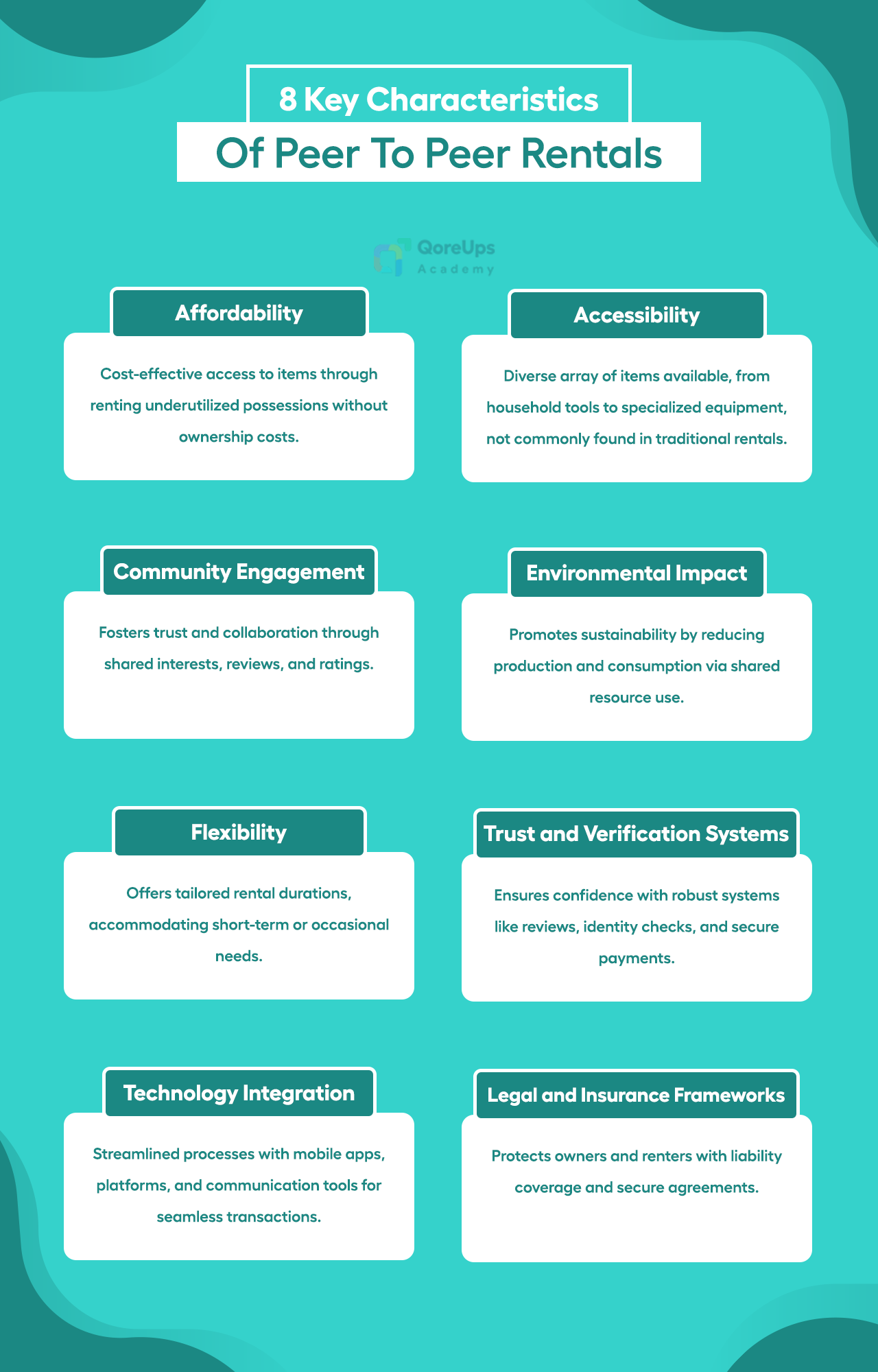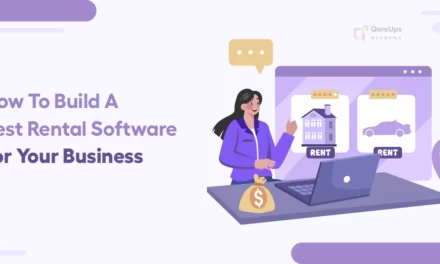The evolution of rental in the digital age has birthed a groundbreaking concept: (P2P) peer to peer rental marketplaces.
These platforms redefine traditional exchanges by facilitating direct transactions between individuals, and cutting out intermediaries.
P2P rental marketplaces have become synonymous with collaborative consumption, transforming the way we access goods and services.
Let’s dive into this comprehensive guide of peer to peer renting!
What Is Peer To Peer Rental Marketplace?
Peer to peer rental (P2P) is a dynamic and innovative sharing economy model that transforms the way people access and utilize goods and services.
Unlike traditional ownership models, where individuals purchase and possess items outright, P2P rental facilitates the temporary exchange of goods between individuals.
This peer to peer rental marketplace idea has gained significant traction across various industries and is reshaping the landscape of consumption.
8 Key Characteristics Of Peer To Peer Rentals
P2P rental marketplaces are characterized by their emphasis on affordability, accessibility, and community engagement.
Users benefit from cost-effective access to items they need for specific occasions, while simultaneously fostering a sense of shared responsibility and trust within the community.
Affordability
Peer to peer rentals promote cost-effective access to a wide range of items.
This affordability is a result of individuals renting out their underutilized or idle possessions, allowing others to use them without the high upfront costs associated with ownership.
Accessibility
The P2P rental business model enhances accessibility by providing a diverse array of items that may not be readily available through traditional rental services.
This can include everything from household items and electronics to specialized equipment or tools, fostering a more inclusive and versatile rental market.
Community Engagement
The community lies at the heart of the P2P rental marketplace platform.
These platforms often create a sense of community by connecting individuals with shared interests or needs.
Users participate in a collaborative economy, building trust within the community through reviews, ratings, and shared experiences.
Environmental Impact
Peer to peer rentals aligns with sustainability goals by encouraging the shared use of resources, reducing the need for mass production and consumption.
This sustainable approach helps minimize the environmental impact associated with manufacturing, transportation, and disposal of goods.
Flexibility
Peer to peer rentals offers flexibility in terms of rental durations and choices. Users can rent items for specific durations, whether it’s for a few hours, days, or longer.
This flexibility caters to the diverse needs of users who may only require items for short-term or occasional use.
Trust and Verification Systems
To build confidence among users, P2P rental marketplace platforms implement robust trust and verification systems.
These may include user reviews, identity verification, and secure payment processes.
Establishing trust is essential for the success and growth of P2P rental communities.
Technology Integration
Peer to peer rentals leverage technology to streamline processes, making it easy for users to list items, find what they need, and complete transactions securely.
Mobile apps, online platforms, and integrated communication tools play a crucial role in facilitating smooth interactions within the community.
Legal and Insurance Frameworks
To address concerns related to liability and damage, P2P rental marketplace platforms often establish legal and insurance frameworks.
These frameworks help protect both the item owners and renters, ensuring a fair and secure environment for transactions.

Advantages Of Starting A Peer To Peer Rental Marketplace
Whether you are a renter seeking affordable access to various items, an owner looking to monetize idle assets, or a marketplace creator aiming to build a community, P2P rental offers a plethora of advantages.
Let’s see the advantages in detail.
Peer To Peer Renters Advantages
- Cost Efficiency: Without intermediaries, rental prices are generally more affordable, allowing users to access items at a fraction of the cost of ownership.
- Expense Sharing: Many rental apps focus on shared expenses, making them economical choices for users seeking cost-effective solutions or second-hand products.
- Diverse Options: P2P rental marketplace platforms provide a single hub where users can explore numerous options for their specific needs, offering a variety of choices in one convenient location.
Advantages for Item Rental Owners
- No Advertising Costs: Sellers don’t need to pay for advertising since their offerings are listed as viable options on the platform, reaching a broad audience of potential buyers.
- Wide Reach: Successful P2P marketplaces attract a large number of buyers, providing sellers with extensive visibility for their products or services.
- Commission-Free Transactions: P2P platforms eliminate the need to pay commissions to intermediaries, allowing sellers to retain a higher portion of their earnings.
Advantages for Peer to Peer Rental Marketplace Creators
- Simplified Logistics: Marketplace creators are relieved of concerns related to shipping logistics and product management, as the peer to peer nature of transactions handles these aspects.
- Flexible Business Models: Marketplace creators have the flexibility to choose a business model that aligns with their business goals, whether it’s a subscription based marketplace, transaction-based marketplace, or another approach that suits their business.
- Community Building: By encouraging a sense of community, marketplace creators can develop a user base that identifies with and is loyal to their rental marketplace platform.
Apart from these advantages peer to peer rentals have other 2 major advantages.
No Inventory Needed
P2P rental marketplaces operate on an asset-light model, distinguishing them from traditional rental businesses.
Instead of maintaining large inventories, these platforms serve as intermediaries, connecting those with resources to spare directly with those in need.
This not only reduces operational complexity but also fosters a more dynamic marketplace.
By eliminating the need for extensive inventories, the P2P rental marketplace platform can focus on fostering a vibrant community.
Successful platforms leverage this advantage to create a dynamic marketplace where users actively participate in sharing, lending, and borrowing.
This approach enhances user engagement and satisfaction.
Network Effects in Online Rental Marketplaces
Network effects are fundamental to the success of P2P rental marketplace platforms.
As more users join, the value of the platform increases exponentially for all participants.
Understanding and fostering network effects involve strategic initiatives to attract and retain users, creating a self-reinforcing cycle of growth.
A growing user base brings numerous benefits.
User growth leads to a more diverse range of items available for rent, faster response times, and increased overall reliability.
This, in turn, enhances the rental marketplace experience for all users, creating a robust and thriving ecosystem.

Essential Features for Peer To Peer Rental Marketplaces
Creating a successful peer to peer rental market place involves incorporating key features that enhance user experience, trust, and functionality.
Whether you build a P2P marketplace from scratch or opting a rental marketplace builder make sure you have the following features.
User Profiles, Reviews, and Ratings 🌐📊
User profiles, reviews, and ratings are the pillars of trust in online rental marketplaces. Transparent and detailed user profiles, coupled with genuine reviews and ratings, provide users with the information needed to make informed decisions and build a sense of community reliability.
Seamless Item Listing and Search Functionality 🔄🔍
A user-friendly interface is crucial for success.
Seamless item listing and search functionality ensure that users can easily find what they need and that item owners can effectively showcase their offerings.
This simplifies the entire rental process, making it efficient and enjoyable.
Secure and Transparent Payment Systems 🔒💳
Secure and transparent payment systems are non-negotiable.
Implementing reliable and secure payment processes not only protects users from fraud but also fosters confidence, encouraging more transactions and contributing to the overall health of the marketplace.
Messaging Systems for Communication 📬💬
Effective communication is the linchpin of successful transactions.
Messaging systems facilitate clear and prompt communication between renters and lenders, ensuring a smooth and positive experience.
This feature is vital for coordinating rental details, addressing queries, and resolving issues.
How To Build A Peer To Peer Rental Marketplace?
Building a thriving peer to peer rental market place business doesn’t have to be a time-consuming or costly endeavor.
Instead, view it as a learning journey with iterative steps.
Building successful ventures is a gradual process. In essence, there are either five or four key steps to launch your marketplace efficiently.
While we’ll briefly touch on them here, for a more in-depth exploration of each step, refer to our comprehensive guide on creating an MVP marketplace.
Identifying and Validating Your Rental Niche
Before diving into the development of your peer to peer rental marketplace, the crucial first step is to meticulously identify and validate your rental niche.
This involves comprehensive market research to understand user needs, assess demand, and ensure that your chosen niche aligns seamlessly with the overarching goals and vision of your platform.
By delving into the specifics of your market, you lay the foundation for a unique and successful venture.
- Market Research: Conduct thorough market research to identify potential niches in the rental space. Understand user behaviors, pain points, and preferences. Analyze existing competitors and their strengths and weaknesses.
- User Needs Assessment: Engage with potential users through surveys, interviews, or focus groups to understand their needs and preferences. Identify gaps in existing rental solutions that your platform could fill.
- Demand Analysis: Evaluate the demand for your chosen niche. Consider factors like target audience size, frequency of use, and potential growth. Ensure that there’s a sustainable market for your chosen niche.
- Alignment with Platform Goals: Ensure that the chosen niche aligns with the overarching goals and vision of your platform. Consider how this niche contributes to the unique value proposition of your marketplace.
Choosing the Right Business Model for Your Marketplace
With your rental niche in focus, the next step involves strategically selecting the right business model for your marketplace.
Whether it’s a commission-based structure, subscription model, freemium approach, or a hybrid of these, this decision is critical for the sustainability and success of your platform.
Careful consideration of the pros and cons of each model is essential, as it shapes the way your platform generates revenue and interacts with its user base.
- Commission-Based Model: Earn a percentage of each transaction made on the platform. This model aligns revenue with actual usage but may require a critical mass of transactions to be profitable.
- Subscription-Based Model: Users pay a recurring fee to access the platform’s services. This model provides a steady stream of income but requires a compelling value proposition to justify ongoing subscriptions.
- Freemium Model: Offer basic services for free and charge for premium features. This can attract a large user base initially, with the potential to upsell premium services to a subset of users.
- Hybrid Models: Combine elements of different models to create a customized approach that suits your platform’s specific needs.
- Consider Legal and Financial Implications: Ensure that your chosen business model complies with local regulations and that the financial aspects are sustainable for both users and your platform.
Building the Minimum Viable Product (MVP)
Once your niche and business model are defined, it’s time to bring your vision to life by developing the Minimum Viable Product (MVP).
This serves as the initial testing ground for your concept, allowing you to gather invaluable insights from real users.
The focus here is on creating a functional and user-friendly platform that enables iterative improvements based on actual user interactions and feedback, ensuring that the final product meets user expectations.
- Core Features: Develop the essential features that define your platform. For an online rental marketplace, this might include user profiles, search and listing functionality, secure payment systems, and communication tools.
- Usability: Prioritize a user-friendly interface and a seamless user experience. The goal is to gather meaningful feedback on the core functionality of your platform.
- Feedback Mechanisms: Implement ways for users to provide feedback on their experience. This could include surveys, ratings, and reviews. Actively encourage users to share their thoughts.
- Iterative Development: Be prepared to make quick iterations based on the feedback received. The MVP phase is about refining your concept and ensuring that it meets user expectations.
Learning from Early User Feedback and Scaling
The journey doesn’t end with the MVP; it evolves.
Learning from early user feedback becomes a continuous and integral part of the process.
By carefully analyzing user insights, iterating on the platform, and expanding features based on evolving needs, you set the stage for scaling.
As your user base grows, strategic scaling strategies are explored, ensuring that your platform can accommodate increased demand while maintaining its success and relevance in the dynamic online rental marketplace.
- Feedback Analysis: Analyze the feedback received during the MVP phase. Identify patterns, common issues, and areas for improvement. Use this information to enhance the user experience and address any shortcomings.
- Feature Expansion: Based on user feedback and evolving market trends, expand the features and services offered by your platform. This might involve adding new categories, refining search algorithms, or enhancing security measures.
- Marketing and Growth Strategies: Develop marketing strategies to attract more users. This might include targeted advertising, partnerships, or referral programs. Consider scalability in terms of server infrastructure and support systems.
- Community Building: Foster a sense of community among your users. Encourage interactions, user-generated content, and loyalty programs. A strong community can contribute to the organic growth of your platform.
- Scaling Responsibly: As your user base grows, ensure that your platform can handle increased demand. Invest in scalable infrastructure, customer support, and security measures. Explore partnerships and collaborations to expand your reach.
Now, let’s see who is running the peer to peer rental marketplace successfully!

Peer To Peer Rental Marketplace Examples
The rise of peer to peer renting has revolutionized the way individuals engage with the sharing economy.
Among the pioneers in this movement are platforms like Airbnb and Turo, each offering a unique approach to unlocking the latent potential of privately owned assets.
Both platforms have not only altered consumer behaviors but have also sparked a broader conversation about the collaborative consumption of resources, community trust, and the redefinition of travel and transportation norms.
Airbnb
- Primary Focus: Airbnb is a global online rental marketplace that facilitates lodging and tourism experiences. It was founded in 2008 and has grown to become one of the most popular platforms for short-term accommodation rentals.
- Accommodations: Initially, Airbnb focused on short-term accommodations such as private rooms, entire homes, apartments, and unique properties. Hosts (property owners) can list their spaces on the platform, and travelers can book these spaces for a specified period.
- Expansion: Over time, Airbnb expanded its offerings beyond accommodations. It introduced “Experiences,” allowing hosts to offer unique activities or tours to travelers. This diversification aimed to enhance the overall travel experience for users.
- Long-Term Rentals: Airbnb has also ventured into long-term rentals, enabling hosts to rent their properties for extended periods. This move caters to individuals seeking more extended stays, such as business travelers or those relocating to a new city.
- User Ratings and Reviews: One of Airbnb’s key features is its review system. Both hosts and guests can leave reviews, contributing to a reputation system that helps users make informed decisions.
Turo
- Formerly RelayRides: Turo, initially known as RelayRides, was founded in 2009 as a peer to peer car sharing platform.
- Car Rentals: Turo allows car owners to rent out their personal vehicles to other individuals. This concept provides an alternative to traditional car rental services by utilizing privately owned cars.
- Booking Process: Users looking to rent a car can browse available vehicles on the Turo platform, selecting the one that meets their needs. The booking process is conducted entirely online, including payment and communication between the car owner and renter.
- Insurance: Turo provides insurance coverage for both car owners and renters. This coverage helps protect against potential damages during the rental period.
- Car Owners: Individuals with a vehicle they don’t use all the time can earn income by renting it out through Turo. The platform provides a way for owners to monetize their cars when not in use.
- Variety of Vehicles: Turo offers a diverse range of vehicles, from economy cars to luxury vehicles and specialty cars, allowing renters to find options that suit their preferences and needs.
Though we’ll provide a brief overview here, for a more detailed examination, please refer to our extensive guide on the Turo case study.
Both Airbnb and Turo have disrupted traditional markets by creating platforms that leverage peer to peer interactions, enabling individuals to share their assets (whether homes or cars) with others for financial gain.
They have also introduced new dynamics to the travel and transportation industries by emphasizing community, trust, and user experience.
5 Challenges of Peer To Peer Rental Marketplace
There may be some common problems you may have when you start your peer to peer rental market place entrepreneurial journey.
Solving the Wrong Problem
Validation is Key. Before committing substantial time and resources, ensure that your business idea is validated.
Swiftly launch the initial version of your marketplace and gather feedback from early users.
This iterative approach allows you to refine and enhance your platform based on real-world insights.
Finding Product-Market Fit
Start Small and Niche. Focus on a specific niche and vertical initially.
While aiming for grand aspirations is commendable, concentrating on a defined market in the early stages is crucial.
Establishing product-market fit within a smaller scope provides a solid foundation for future expansion into broader markets and categories.
Identifying the Right Business Model
Prioritize Sustainability. Choose a marketplace business model that is sustainable and adaptable to growth.
Ensure that your pricing strategy aligns with the needs of sellers, customers, and the overall sustainability of your business.
Finding the right balance in your pricing model is key to long-term success.
Building and Retaining a User Base
Invest in User Experience.
Creating an intuitive and user-friendly interface is crucial for attracting and retaining users. Prioritize user experience design to make navigation seamless and enjoyable.
Additionally, consider implementing loyalty programs or incentives to encourage user retention.
Managing Financial Resources
Budgeting and Prioritization. Effective financial management is essential, especially in the early stages of your business.
Develop a clear budget that allocates resources wisely, focusing on critical areas such as product development, marketing, and customer support.
Prioritize expenses based on their impact on business growth.

So Finally,
Building a peer to peer rental marketplace business has never been more accessible than it is today.
The model presents extensive opportunities for creativity and growth, offering unlimited potential.
Success in this arena hinges on validate business idea, selecting the right business model, and developing a platform enriched with robust features.
By dedicating time to these crucial steps, you position yourself for success.
It’s essential to maintain an open mind, a commitment to continuous learning and iteration, and, above all, a keen ear for your users’ feedback.
Good luck with your Peer to peer rentals journey!






